| |

ADIAS Press releases and Press coverage - 2002
[ Visit the ADIAS archive
of previous Press releases and Press coverage: 1995-2000 - 2001 - 2002 - 2003
- 2004 - 2005 - 2006
]
13 January 2002
More
water reservoirs found on Futaisi isle (Source: Uaeinteract.com)
2 February 2002
Bid
to protect archaeological wealth on Delma (Source: Uaeinteract.com)
3 February
2002 - New Archaeological Discoveries in Fujairah and Ras Al Khaimah
Important new archaeological discoveries have been made on the coastal
plain of Fujairah and in southern Ras Al Khaimah, not far from the village
of Muna’i as a result of work being carried out in association
with the building of the new water pipeline from the Fujairah coastal
town of Qidfa to Al Ain, it is announced today.
The water pipeline, and an associated desalination plant are being constructed
for the new Union Water and Electricity Company, UWEC, created last
year under the aegis of the UAE Offsets Group. The plant will have an
installed daily production capacity of 620 mg of electricity and 100
million gallons of water, with water being pumped through a pipeline
over the Hajar Mountains to Al Ain.
In accordance with relevant federal and local environmental protection
legislation, UOG requires that environmental studies and archaeological
surveys are carried out as an integral part of all projects, in order
to identify and, where possible, to protect areas of environmental or
archaeological sensitivity.
As part of this process, experts from the Abu Dhabi Islands Archaeological
Survey, ADIAS, were commissioned to undertake an environmental and archaeological
baseline study of the 180 km. pipeline route from Qidfa, around 20 km.
north of Fujairah City, to Al Ain. During the survey, over 20 previously
unrecorded archaeological sites were identified. Of these, the most
significant were in the southern part of Ra’s al-Khaimah, near
Manduk and Muna’i, and on the Fujairah coastal plain, at Qidfa
itself and near the village of Qurrayah.
Following the identification of the sites, UOG, ADIAS, and representatives
of the pipeline contractors, Technip / Al Jaber, and of consultants
Fichtner and Dames and Moore worked together last month to agree on
the necessary action to protect or investigate the sites. For those
in the mountains, which included a large copper-smelting complex dating
back to the mid and Late Islamic period (14th to 17th centuries AD),
and near Qurayyah, it was decided to make minor amendments to the pipeline
route and to fence the archaeological sites so that they could be investigated
at a later date.
The sites at Qidfa, however, lie close to the desalination plant and
associated tank farm, and an alternative route for the pipeline did
not exist.
It was, therefore, decided that an urgent archaeological investigation
be undertaken by ADIAS at Qidfa. Working closely with representatives
of UOG and Technip / Al Jaber, the ADIAS team, led by Academic Director
Dr. Geoffrey King, of London University, first surveyed and marked the
sites, to identify those which would be affected by the pipeline route.
This was followed by a systematic collection of all pottery from the
surface of the site. Study of the pottery shows that while much of it
can be dated to the Late Islamic period (15th Century to 18th Century),
some comes from the early and mid-Islamic periods (7th to 14th Century),
and some is of Late pre-Islamic date (3rd to 7th Century AD). Some other
pieces of pottery have not yet been definitely identified, but may date
back to the local Iron Age (1300 – 300 BC), or even to the Bronze
Age (c. 3000 BC to 1300 BC).
With the pottery collection completed, Dr. King and an associate then
excavated some of the ancient architectural features visible on the
Qidfa plain. He was assisted by labourers provided by the Fujairah Museum
on the instructions of Supreme Council member and Ruler of Fujairah
His Highness Sheikh Hamad bin Mohammed Al Sharqi, who also provided
useful advice on the minor re-routing of the pipeline at Qurayyah.
The features examined by the ADIAS team included an ancient falaj (irrigation
channel) a large wall and the remains of a fortified tower and two adjacent
walls, perhaps originally a defensive structure. Almost all of these
have now been protected with fencing.
Further work at Qidfa is planned for later this month, while, with the
key sites now clearly identified, construction of the pipeline route
is continuing as planned.
According to Dr. King: “there is extensive evidence of occupation
from elsewhere on the Fujairah coastal plain from the Late Islamic period
and from the Bronze and Iron Ages. The evidence of occupation at Qidfa
during the Late pre-Islamic and early Islamic periods represents, however,
an important addition to the historical picture of occupation along
the East Coast. The enlightened approach displayed by UOG has contributed
in a very significant way to our knowledge of the UAE’s past.”
Mubarak Al Dhahiri, of the UAE Offsets Group, commented: “Protection
and preservation of the environment and heritage of the United Arab
Emirates is an important part of the philosophy of UOG. While our main
concern is, of course, to contribute to the development of the country,
we are determined to ensure that, wherever possible, this is undertaken
within the framework of conserving our past. This exercise at Qidfa
and elsewhere along the pipeline route shows clearly that the two objectives
can be pursued side by side. We will continue to work with ADIAS and
with the various environmental agencies throughout the country to safeguard
the national heritage of the UAE.”
Further information from:
UOG Communications Department
Tel: +971 2 6277794
Fax: +971 2 6274148
Email: info@uaeoffsets.co.ae
Web: www.uaeoffsets.com
3 February 2002
ADIAS
identified 20 new sites along RAK-Fujairah coast (Source: Uaeinteract.com)
7 February 2002
Archaeological
finds in Fujairah and Ras Al Khaimah (Source: Uaeinteract.com)
Archaeological
site inspected (Source: Gulf
News)
13 February 2002
More water reservoirs found on Futaisi isle (Source:
Gulf News)
Spanish
team to resume excavations (Source: Gulf
News)
25 February 2002
Study of Jebel Dhanna sulphur mines completed
FOR IMMEDIATE RELEASE 25th February 2002
A fourth phase of archaeological investigations into a complex of sulphur
mines at Jebel Dhanna, in Abu Dhabi’s Western Region, has recently
been completed by the Abu Dhabi Islands Archaeological Survey, ADIAS,
it is announced today.
The investigations were carried out with the support of the Abu Dhabi
Company for Onshore Oil Operations, ADCO, and focused on the part of Jebel
Dhanna that falls within the oil export terminal facilities of ADCO.
The sulphur mines, the only ones of their type known anywhere in the United
Arab Emirates, were first recorded by ADIAS during an Archaeological Baseline
Study of the ADCO concession area in 1998. The second and third phases
of study of the mines were carried out in 2000 and 2001, and the recent
work brings to an end the fieldwork component of the ADIAS study.
The recent fieldwork was directed by Daniel Hull, ADIAS’s Resident
Archaeologist, with the support of Stephen Rowland, an environmental archaeologist
from York, in Britain.
In all, a total of 180 mine shafts have been recorded by ADIAS within
the ADCO terminal area, some going as deep as 10 or 12 metres into the
hillside. Many are also linked to underground chambers and tunnels, with
domed roofs, ledges, ventilation and light holes and steps cut in the
rock to allow access from above. Preliminary estimates suggest that as
much as 1500 cubic metres of rock may have been removed during the mining
operations, with as much as 90 tonnes of sulphur being recovered. The
remains of a number of collapsed rock shelters and water catchment systems
have also been recorded by the ADIAS team, while environmental data has
been recovered which will help to provide an idea of what the miners ate,
and how they lived.
With the fieldwork component of the investigations now completed, the
ADIAS team are now analysing the finds from the mines, and are also arranging
for radiocarbon dating to be carried out on ash and charcoal recovered
from the vicinity of some of the shafts. This will help to provide an
idea of the date of the mining operations.
Pottery collected from around the mine sites is from the Late Islamic
period, 100 to 400 years ago. Historical research, however, has not yielded
any references to the mining operations over the last couple of hundred
years, and it seems, therefore, that the main phase of activity at Jebel
Dhanna may have taken place 200 to 400 years ago. A regional trade in
sulphur is known from the late 17th and 18th Centuries, with records of
sulphur shipments being known from mines on the Iranian side of the Arabian
Gulf.
Once the analysis of the finds is complete, ADIAS plans to prepare a special
publication on the Jebel Dhanna mines.
“We are delighted, once again, to be able to thank ADCO for their
support for our work,” ADIAS Executive Director Peter Hellyer said.
“Since the Abu Dhabi Islands Archaeological Survey was established
in 1991, we have been able to count on ADCO for support, and we are particularly
grateful for the facilities they have extended to us for research in the
onshore oilfields and other parts of their concession area.”
ADIAS has so far identified around 125 archaeological sites within ADCO’s
sphere of operations.
Welcoming the completion of the ADIAS fieldwork, ADCO General Manager
Andre van Strijp commented: “Under the terms of its Health, Safety
and Environment, HSE, policy, ADCO is committed to the identification
and preservation of the national heritage of the United Arab Emirates.
In particular, it is an essential part of this policy that archaeological
sites within the Company’s operational areas are protected and studied.
We are delighted to have been able to work with ADIAS on the investigation
of these sulphur mines, which are an important part of the industrial
history of the UAE.”
The Abu Dhabi Islands Archaeological Survey was established on the instructions
of President His Highness Sheikh Zayed bin Sultan Al Nahyan in 1991, and
operates under the patronage of His Highness Lieutenant General Sheikh
Mohammed bin Zayed Al Nahyan. Charged with responsibility for archaeological
and fossil sites on the coast, islands and elsewhere in Abu Dhabi’s
Western Region, it has so far recorded over 1000 archaeological sites.
More details of ADIAS activities can be found on its website:
www.adias-uae.com
Issued by
Abu Dhabi Islands Archaeological Survey, ADIAS
PO Box 45553, Abu Dhabi
Further Information from:
Peter Hellyer (Executive Director): tel: 050-642-4357
or
Daniel Hull (Resident Archaeologist): tel: 050-771-4942
26 February 2002
Team analyses archaeological sulphur mines (Source:
Gulf News)
Study
of Jebel Dhanna sulphur mines completed (Source: Uaeinteract.com)
11 March 2002
New
light shed on Dalma site (Source: Gulf
News)
New
evidence for the UAE's oldest ancient village on Dalma Island (Source:
www.uaeinteract.com)
14 March 2002
Important archaeological discoveries at Dalma island (Source:
www.uaeinteract.com)
9 April 2002
Archaeological
treasures in focus (Source:
www.uaeinteract.com)
Archaeological
treasures in focus (Source: Gulf
News)
27 April 2002
British experts undertake study of UAE crabs
FOR IMMEDIATE RELEASE 27th April 2002
Two British scientists have
recently completed a study of UAE crabs. Dr. Peter Hogarth, a marine
biologist from the Department of Biology at the University of York in
the UK, and Dr. Mark Beech, of the Abu Dhabi Islands Archaeological
Survey (ADIAS) and a Research Fellow in the Department of Archaeology
at the University of York, have been systematically recording and collecting
the crab species which occur along the coastline of the United Arab
Emirates.
The purpose of this study
is to compile a reference collection in order to identify archaeological
crab remains recovered from a number of archaeological excavations in
the Emirates. The crab reference collection resulting from this study
will in the future be retained within the Marine Environment Research
Centre (MERC) which is part of the Environmental Research and Wildlife
Development Agency (ERWDA) in Abu Dhabi.
An important part of Hogarth
and Beech's work is a baseline study which maps the occurrence of modern
day crab species along the UAE coastline. One of the interesting outcomes
of their work is the first authenticated record in the Arabian Gulf
of the crab species, Scylla serrata or mangrove crab. Although the presence
of mangrove crabs has been suspected from observation of burrows, or
from anecdotal evidence, no firm records existed until recently, when
a single specimen was reported from Ras al-Khaimah, caught in a mangrove
lagoon. A note on this has recently been published by Hogarth and Beech
in the locally produced publication, "Tribulus", the journal
of the Emirates Natural History Group.
The mangrove crab is the
largest of the swimming crabs (family - Portunidae), reaching a carapace
breadth of 22-23 cm and a weight of 1.5 - 2.0 Kg. It is widespread in
the Indian Ocean and western Pacific, and in many areas is an important
food species either trapped or reared in aquaculture systems. This species
is strongly associated with mangroves, where it spends much of its life
cycle, excavating burrows in the soil from which it emerges to forage.
Remains of mangrove crab
have been recognised at several archaeological sites in the Emirates
including the Iron Age site of Rafaq in the Wadi al-Khawr, and in Sasanian/Islamic
levels at Kush in Shimal, Ras al-Khaimah. The Rafaq site is located
some 25 km inland from Kalba on the east coast of the Emirates. The
strong association of this particular crab species with mangroves indicates
that human populations were dependent on mangroves, and were already
exploiting them for food and other resources like fuel and timber, as
long as 3000 years ago.
Why should a species, once
abundant enough to be a significant food source, have largely vanished
from the Arabian Gulf? The most probable explanation in this case is
the loss of the mangrove habitat. In the past mangroves were much more
widespread in the Gulf. Their use as timber for architecture and boat-building,
as well as for fuel, has severely depleted mangroves in the Gulf, reducing
them in area and diversity to relatively small patches, almost exclusively
of the Grey mangrove, Avicennia marina.
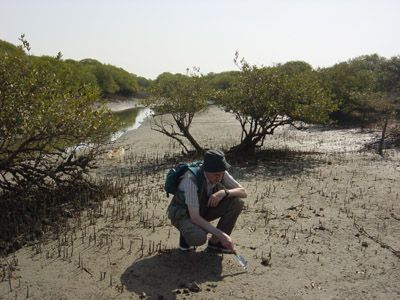
Figure 1.
Dr. Peter Hogarth of the University of York searching for crabs in Ras
Al Khaimah.
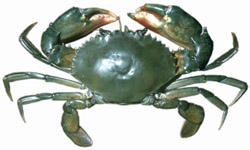
Figure 2.
The mangrove crab, Scylla serrata.

Figure 3.
3000 year old mangrove crab claws from archaeological deposits at the
Iron age site of Rafaq.
For further information please contact:
Dr. Mark Beech
Abu Dhabi Islands Archaeological Survey (ADIAS)
P.O. Box 45553,
Abu Dhabi,
United Arab Emirates
Tel (mobile) 050 7527407
Email: adias@erwda.gov.ae
and,
Honorary Visiting Fellow,
Department of Archaeology,
University of York,
York Y01 7EP,
UK
Email: mjb117@york.ac.uk
Dr. Peter Hogarth,
Department of Biology,
University of York,
York YO1 5DD,
UK
Email: pjh4@york.ac.uk
28 April 2002
British
scientists complete study on crabs (Source:
Gulf News)
7 May 2002
New Finds prove importance of Abu Dhabi Airport Archaeological Site
FOR IMMEDIATE RELEASE on 7 May 2002
Further fieldwork carried out at an archaeological site at the Abu Dhabi
Airport Golf Club, coupled with a detailed study of the flint tools
recovered during earlier work at the site have confirmed the importance
of the site during the Late Stone Age period, around 5,500 to 4,000
BC, it is announced today.
The Airport site was first
discovered on a range of low hills inside the perimeter of the Golf
Club in 1995, when a short season of fieldwork was undertaken by the
Abu Dhabi Islands Archaeological Survey, ADIAS. That work showed that
the site had been occupied during the Late Stone Age, the early to middle
Bronze Age, around 3,000 BC to 2,000 BC, and in the Late pre-Islamic
period, around the beginning of the Christian era.
During late April, a review
of the stone tools and animal remains from the site was undertaken by
the ADIAS flint tools expert, Dr. Heiko Kallweit, from Germany's University
of Freiburg, with the assistance of Dr. Mark Beech, ADIAS environmental
archaeologist from Britain's University of York. This involved a detailed
re-examination of material collected during the 1996 field season, as
well as two further visits to the site, to search for new material that
might have been uncovered as a result of the rains early last month.
"This review and the
two site visits have produced valuable new information," Dr. Kallweit
said today. "The site was proved to extend further than had been
originally recognised, and a nearly complete flint arrowhead was recovered
on the southern fringes of the site (Figures 1-2), as well as a lot
of other worked flint material. The arrowhead was of a type not previously
known to have been found in the United Arab Emirates, although similar
examples have been found in western Saudi Arabia and in Qatar. This
find provides valuable new information on the possibility of trading
routes stretching right the way across the Arabian peninsula during
the Late Stone Age period."
During the site visits, Dr.
Kallweit also found a tiny crescent-shaped fragment of worked flint,
known as a microlith, that provides useful insight into the way of life
of the UAE's Late Stone Age inhabitants. Two further examples were also
identified during the detailed review of material collected during the
earlier phase of fieldwork.
"The three pieces are
"teeth" of flint that would have been set into a wooden handle
for use as an early sickle or knife for cutting grasses," Kallweit
said. "Once again, no evidence of such a sickle has previously
been recorded in the Emirates, although examples are known from other
regions in the Near East. The discovery confirms that the people were
harvesting grasses or grains, although it is not possible yet to determine
whether they were growing crops, or just harvesting wild plants."
Along with evidence of sheep,
goat and cattle bones found on archaeological sites on Dalma, in the
far west of the UAE, and at Jebel Buhais, in Sharjah, the sickle pieces
confirm that the Late Stone Age inhabitants of the UAE were not simple
hunters and gatherers, but were a pastoral community with a much broader
economic base to their lifestyle, Kallweit says.
The newly-identified information
has prompted ADIAS to plan for a further season of fieldwork at the
Airport site next winter.
James McLean, Manager of
the Abu Dhabi Airport Golf Club, welcomes the ADIAS plan.
"The Club and its members
are proud to have such an valuable archaeological site within its course,"
he said. "No other golf club in the country has anything like it,
and we will provide ADIAS with any facilities and help that we can in
order to help them discover more information about the site. We look
forward to working with ADIAS next winter on this important study into
the UAE's heritage and history."
The first phase of archaeological
investigations at the Abu Dhabi Airport Golf Club in 1996 were undertaken
by ADIAS with the support of the Chairman of Abu Dhabi's Civil Aviation
Department, HE Sheikh Hamdan bin Mubarak Al Nahyan, and were supported
by the Abu Dhabi Duty Free.
"Our first phase of
work proved the importance of this site, and we are grateful for the
support provided by Sheikh Hamdan and by Abu Dhabi Duty Free, and for
the way in which they have helped to preserve the site," says Peter
Hellyer, the ADIAS Executive Director. "We hope that next winter's
work will not only lead to yet more important discoveries, but will
also show the way in which bodies like Civil Aviation and Duty Free,
as well as the Golf Club, can work together with us in the protection
of the country's heritage."
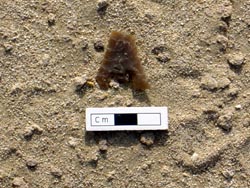
Figure 1 - The flint arrowhead
found in-situ at the Abu Dhabi Aiport site.
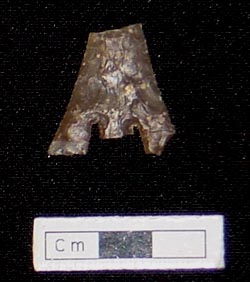
Figure 2 - The flint arrowhead
from the Abu Dhabi Airport site.
7
May 2002
New
Finds prove importance of AD Airport Archaeological Site (Source:
www.uaeinteract.com).
8 May 2002
More
Late Stone Age artefacts found (Source:
Gulf News)
New
light on archaeological sites (Source:
Khaleej Times)
12
May 2002
New results from Sir Bani Yas study
FOR IMMEDIATE RELEASE on
12 May 2002
A short season of studying excavated material from pre-Islamic Christian
archaeological sites on Abu Dhabi's islands of Sir Bani Yas and Marawah
undertaken by specialists working for the Abu Dhabi Islands Archaeological
Survey, ADIAS, has yielded important new dating about the structure
of the settlements, and about their cultural links with elsewhere in
the peninsula, it is announced today.
The two sites, identified
by ADIAS in 1991, on Sir Bani Yas, and 2000, on Marawah, are the only
confirmed archaeological evidence of the presence of Christians in south-eastern
Arabia in the period immediately before the coming of Islam in the 630s.
The Director of the excavations
at the two sites, Dr. Joe Elders, who is also in charge of archaeology
for many of Britain's churches, and Dr. Emma Loosley, from the University
of York, an expert in the early history of Christianity in the Arab
Middle East, completed a two week study of the pottery and plaster from
the Sir Bani Yas and Marawah sites last month.
According to Elders and Loosley,
a study of the plaster from the Sir Bani Yas site indicates that the
inhabitants of the monastery were influenced by cultural links with
Arab Christian communities in parts of the Levant, such as Syria. Historical
research carried out by Elders and Loosley also suggests that the Christian
communities of the Gulf were also closely involved in the pearling industry
prior to the coming of Islam to the region.
As part of plans for further
study of the plaster, pottery and glass fragments from the sites, ADIAS
will shortly be sending some samples to Britain for examination. This
will permit comparisons to be made with other material from the middle
of the First Millennium AD from the Gulf, Mesopotamia and Syria.
Help in shipping the samples
is being provided to ADIAS by the UAE representative office of oil company
BP, (formerly British Petroleum), which has supported the work of ADIAS
for several years.
"We are delighted to
be of assistance to ADIAS in their important programme of research into
the heritage of the UAE," said Dr. Michael Daly, President, BP
Gulf States Business Unit in Abu Dhabi. "BP has a history of nearly
eighty years involvement with the country and is heavily involved in
the UAE's current and future development programme, and it is a pleasure
to extend this involvement into the field of historical research."
Said an ADIAS spokesman ,"Over
the years since ADIAS was first established, it has benefited substantially
from the support extended by the local and foreign oil sector, including
BP " . We are most grateful for this continued support from BP,
which will help us to undertake further scientific research into the
results from these two important archaeological sites."
Further information from:
Peter Hellyer,
Executive Director,
ADIAS
Tel: +971 50 6424357
Fax: +971 2 4450458
12 May 2002
New results from Abu Dhabi Islands Archaeological Survey (Source:
Uaeinteract.com)
13 May 2002
New
data from Sir Bani Yas study (Source: Uaeinteract.com)
19 June 2002
Data on UAE fossils added to ADIAS website
FOR IMMEDIATE RELEASE on
19 June, 2002.
The Abu Dhabi Islands Archaeological Survey, ADIAS, has added full details
of the six million year old fossils of Abu Dhabi's Western Region to
its website, it is announced today.
Dating from the Late Miocene
period, the fossils were discovered during the late 1980s and early
1990s by the Abu Dhabi Miocene Project, a joint research study directed
by Peter J. Whybrow (Natural History Museum, London) and Andrew Hill
(Yale University, U.S.A.). Support for the research was provided by
the Abu Dhabi Company for Onshore Oil Operations, ADCO.
The majority of the fossils
collected by the Natural History Museum/Yale University team come from
Baynunah Formation outcrops located between the coast and the road from
As Sila'a to Abu Dhabi.
They include fossil bones
of early ancestors of the elephant, hippopotamus, horse, crocodile and
other animals. They indicate that at the time the animals lived, what
is now Abu Dhabi's Western Region was a lush savannah type landscape
with wide and slow-moving rivers, somewhat like East Africa today.
In association with the Environmental
Research and Wildlife Development Agency, ERWDA, ADIAS has now been
assigned responsibility for study and protection of fossil sites in
the coastal zone. During a meeting in London last month between Peter
Whybrow and ADIAS representatives, it was agreed that a full database
on the fossils would be added to the ADIAS website. Access to the new
material can be gained through the following address:
"We would like to thank
Peter Whybrow and his team for providing such an excellent and informative
guide to the Miocene fossils of Abu Dhabi" said Dr. Mark Beech
of ADIAS. "This information supplements our expanding web presence
as one of the major providers of information concerning the archaeology
and palaeontology of the region."
A full scientific account
of the geology and palaeontology of the Miocene period in the Western
Region of Abu Dhabi was published by Yale University Press in 1999 and
titled "Fossil
Vertebrates of Arabia", edited by Peter J Whybrow and Andrew
Hill.
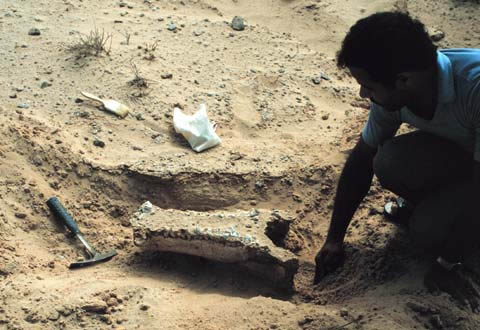
Caption:
Mohammed, a UAE University driver, helping to excavate the jaw of a
6 million year old primitive hippopotamus skull (Hexaprotodon sahabiensis)
in 1981.
Relevant weblinks:
http://www.adias-uae.com/fossils
http://www.yale.edu/yup/books/071833.htm
http://www.adias-uae.com
Further information from:
Peter Hellyer
ADIAS Executive Director
Tel: +971 50 6424357
Fax: +971 2 4450458
email: peter@extinfo.gov.ae
Dr. Mark Beech
ADIAS webmaster
Tel: +44 1904 434995
Fax: +44 1904 433902
email: mjb117@york.ac.uk
21 June 2002
Data
on 6 million-year-old fossils (Source:
Gulf News)
22 June 2002
Data
on six million-year-old fossils (Source: Uaeinteract.com)
17 July 2002
ADIAS
study on Dalma island sites (Source: Uaeinteract.com)
ADIAS
study on Dalma island sites (Source: Gulf
News)
1 September 2002
Focus
on UAE at archaeology conference (Source: Uaeinteract.com)
3 September 2002
Focus
on early coastal habitats (Source: WAM)
Focus
on early coastal habitats (Source: Gulf
News)
21 September 2002
Dates
were eaten in UAE, Gulf during Bronze Age - part 1 & part
2 (Source: WAM)
Dates
were eaten in UAE, Gulf during Bronze Age (Source: Gulf
News)
30 September 2002
Rich
Culture, Rich History, and Rich Prospects for the United Arab Emirates
by Peter Hellyer (Source: The
Earth Times)
9 October 2002
Al
Wathba Lakes: Reconciling Wildlife Conservation and Sustainable Development
by Peter Hellyer (Source: The
Earth Times)
22 November 2002
Future
Perfect (Source: Gulf
News) - read an article about Peter Hellyer, the Executive Director
of ADIAS, which appeared in Gulf News Friday Magazine. Download the
article as separate pages (.jpg files) page
1 - page 2 - page
3 - page 4.
26 November 2002
University
holds history lecture (Source: Gulf
News)
UAE
history dates back to 7,000 years (Source: Uaeinteract.com)
- read about the first in a series of lectures being given at Zayed
University by the Abu Dhabi Islands Archaeological Survey.
30 November 2002
TAKREER
backs fossil research at Ruwais - part 1 - part
2 (Source: WAM)
- read about how Takreer
is sponsoring ADIAS's work on Miocene fossils in Abu Dhabi.
1 December 2002
Move
to protect fossil site (Source: Gulf
News)
Research
on fossils gets boost (Source: Khaleej
Times)
Takreer backs fossil research at Ruwais (Source: Uaeinteract.com)
- read about how Takreer
is sponsoring ADIAS's work on Miocene fossils in Abu Dhabi.
home
|